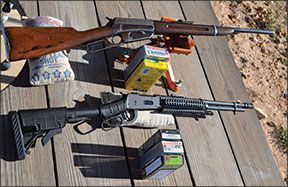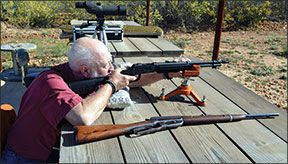For some shooters, Hollywood seems to have become a prime factor in choosing the style and type of firearm finding favor on the range and in the field. This truism seems to be particularly prevalent when dealing with lever-action rifles. In the old days, Westerns ruled the movie screens and a true-blue cowboy had three good companions – “my rifle, my pony and me” – as sung by Dean Martin in the classic western Rio Bravo.

One of those good companions for quite a few cowboys and hunters of that time period was the Winchester Model 1895. The Model 1895 was the first Winchester rifle to feature a box magazine located underneath the action instead of the tubular magazine design, allowing for the use of military and hunting cartridges with pointed bullets, and was the last lever-action rifle to be designed by legendary gunsmith and inventor John M. Browning. For our test, we were able to obtain a vintage Model 1985 in 30-40 Krag that dates back to the early 1900s, when it sold for a mere $25. The specific firearm we used in the test had spent countless hours in a rifle scabbard on horseback or on the side of a truck bouncing through the South Texas brush near Laredo and has accounted for more jack rabbits, coyotes and whitetail deer than can easily be counted.
On the more modern side of the Hollywood depiction of a lever-action shooter is the recently introduced Mossberg Model 464 ZMB 30-30 Win., offering a variety of high-tech features to handle the highly promoted zombie apocalypse. Short and quick with the ability to add all kinds of optics and lights for effective firepower to stop the undead — if they ever make their appearance — or varmints and deer-sized big game, the Mossberg has upgraded the lever-action rifle to a space-age weapon.
Although the calibers are identical — the 30-40 Krag is also known as the 30 U.S. — the Krag provides a little more punch with a larger bullet than the 30-30 Win. Both cartridges are considered prime brush guns for handling small game up to animals the size of a whitetail deer at ranges of 100 yards or less.
It should be noted that while quite a few rifle cartridges are hard to find with the ongoing high ammo demand, the 30-30 rounds are generally easier to obtain than the veteran 30-40 Krag. We were able to obtain three varieties of 30-30 (including the specially marketed Hornady Zombie Max designed for use on the undead) and two brands of 30-40 Krag for our tests. Here’s our report:

Mossberg Model 464 XMB
Lever Action No. 41026
30-30 Win., $535
Although this Mossberg was released to take advantage of the seemingly endless fascination with zombies, the Model 464 XBM is also a space-age version of one of the most popular calibers in the hunting world. In some areas, the Model 464 is similar to the rifles that started the 30-30 on its way to fame — the Winchester Model 1894 that was the first centerfire designed to handle the new smokeless powder cartridge. The smooth, sleek receiver, with its top ejection and side loading port, is a classic example of how a 30-30 should work.
Once we got past the high-tech appearance of the Mossberg and fired a few rounds through the short 16.5-inch barrel complete with flash suppressor, any doubts about this being a solid hunting tool were dispelled. The old-school members of our test group still prefer wood and gun-blue metal, but understand that black synthetic and matt finish do have a place in the hearts of many of their fellow shooters. We were very pleased with the six-position adjustable stock with an adjustable comb that was easy to fit to any of the shooters in our group. When properly adjusted, the rifle snugged up firmly into the shooter’s shoulder, and recoil with the three different types of ammunition was not unpleasant. While the forearm rails are designed for installation of a flash light, laser sight, red dot and other accessories, we stayed with the basics to ensure a fair comparison with the vintage Winchester. Being able to add the variety of accessories is certainly a plus for the Mossberg.
At both the 50-yard outdoor range and the 100-yard underground range, the Mossberg was pleasant to shoot and performed very well. The rifle favored Winchester ammunition, producing an average 2-inch group of three shots at 100 yards. With open sights, that kind of group would satisfy even the most picky brush-busting hunter.
The action of the Mossberg was a little stiff, probably because it was just taken out of the box, and we believe it will smooth out with additional use. The trigger pull of 4.75 pounds was slightly heavier than we would prefer, but did not cause us to downgrade the rifle. We experienced no malfunctions or failures to feed rounds with any of the test ammunition.
Our Team Said: Like the most homely pup in a litter, the Mossberg may be so ugly it is cute, once lever-action aficionados give it a try. If space age is your forte and quality, quick-handling firepower is your goal, the Mossberg easily meets your needs for a close-range brush gun or even for dispatching zombies, should they ever cross your path.
Winchester Model 1895
Lever Action Carbine
30-40 Krag, $1000- $1500
After handling hundreds of rifles over the years, there have been few times when picking up a fresh firearm and sighting down the barrel is like encountering an old friend. The Winchester Model 1895 is one those cases. This rifle should be listed in the dictionary under “old school” with its well-worn stock and forearm and gun-metal blue barrel and receiver — also displaying years of use but not abuse — as appealing to the eye as a fine painting.
As noted earlier, the Model 1895 was the last lever-action rifle ever created by the fertile mind of John M. Browning. The strongest lever-action rifle produced by Winchester, the Model 1895 was designed to handle the increased pressures of smokeless-powder cartridges that were becoming common at the time. One of the rifle’s earliest fans was Theodore Roosevelt, who personally purchased and equipped each of his fellow officers in the Rough Riders with a Model 1895 Winchester in 30 Army (30-40 Krag) for use in the Spanish-American War.
In 2001, Winchester reintroduced the rifle during the 100-year anniversary of Roosevelt’s presidential administration, offering it in 405 Winchester (a caliber highly praised by Roosevelt) as well as 30-06 Springfield and 30-40 Krag. With history on its side, the Model 1895 began with a slight edge in the match-up, and its performance on the range and in the field upheld its lead.
Weighing in at 8 pounds compared to the Mossberg that tipped the scales at 6.75 pounds, the Winchester had a nice heft and balance and produced no more recoil than the smaller 30-30 Win. The average three-shot groups of 2.3 inches with the Winchester 180-grain Power Point bullets and 4.8 inches with the Remington 180-grain Core-Lokt bullets using open sights at the 100-yard indoor range was considered very good by our shooting team.
Sighting down the 22-inch barrel over the V-notched rear sight and tiny bead front sight was both easy and quick. A trigger pull of 4.5 pounds was also a well-appreciated feature of the veteran rifle. It came as no surprise that the action of the Model 1985 was very smooth, making second shots in the field extremely effective. There is a lot to be said about the workings of a vintage rifle that has seen years of quality trigger time and proper maintenance. Although rifles of this quality may be hard to find and carry a hefty price tag when they can be located, this specimen certainly demonstrated that even an old war horse is capable of meeting or exceeding the needs of today’s hunter.
Our Team Said: Very nice accuracy, smooth action, and classic, comfortable handling and features earned the veteran carbine high marks. We can understand why Teddy was such a fan of this Winchester model. The price tag is a little high, as it is with most desirable collector-quality firearms, but that should not be a deterrent for lever-action fans.
Written and photographed by Ralph Winingham, using evaluations from Gun Tests team testers. GT






























